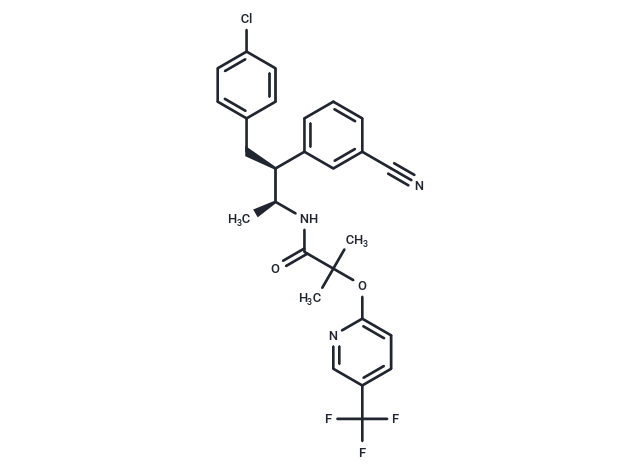Shopping Cart
Remove All Your shopping cart is currently empty
Your shopping cart is currently empty
Taranabant (MK-0364) is a selective and potent cannabinoid 1 (CB1) receptor inverse agonist used in the study of obesity and nicotine dependence.

| Pack Size | Price | USA Warehouse | Global Warehouse | Quantity |
|---|---|---|---|---|
| 1 mg | $99 | - | In Stock |
| Description | Taranabant (MK-0364) is a selective and potent cannabinoid 1 (CB1) receptor inverse agonist used in the study of obesity and nicotine dependence. |
| Targets&IC50 | CB2 receptor:470 nM (Rat), CB2 receptor:310 nM (Ki, Rat), CB2 receptor:170 nM (Ki, human), CB1 receptor (rat):0.4 nM, CB2 receptor:290 nM (human), CB1 receptor (human):0.3 nM, CB1 receptor (rat):0.27 nM (ki), CB1 receptor (human):0.13 nM (ki) |
| In vitro | Taranabant (MK-0364) is a novel, acyclic cannabinoid-1 receptor inverse agonist designed for the treatment of obesity. It binds to human or rat CB1 receptors with an IC50 of 0.3 and 0.4 nM, respectively, corresponding to Ki values of 0.13 and 0.27 nM, respectively. Additionally, Taranabant binds to human or rat CB2 receptors with an IC50 value of 290 and 470 nM, respectively, corresponding to Ki values of 170 and 310 nM, respectively. The selectivity ratio of CB1 receptors over CB2 receptors is approximately 1000-fold[2].The IC50s of Taranabant for CB1 receptors and CB2 receptors by substituted amides are 0.3±0.1 nM and 290±60 nM, respectively. Taranabant is a CB1 receptor inverse agonist with minimal potential for covalent protein binding. It exhibits exceptional potency and selectivity (900-fold over CB2) as a CB1 receptor inverse agonist, showing over a 500-fold improvement in affinity compared to the original lead. In a functional assay of cyclic-AMP production, Taranabant is determined to be an inverse agonist (EC50=2.4±1.4 nM)[1]. |
| In vivo | In C57BL/6N mice, Taranabant (MK-0364) dose-dependently inhibits 2-hour and overnight food intake, as well as overnight gains in body weight. At the oral doses of 1 and 3 mg/kg, Taranabant significantly inhibits 2-hour food intake (36 and 69% reductions, respectively; P<0.05 and P<0.00001, respectively) and overnight food intake (13 and 40% reductions, respectively; P<0.05 and P<0.00001, respectively), along with overnight gains in body weight (48 and 165% reductions, respectively; P<0.01 and P<0.00001, respectively). Taranabant demonstrates dose-dependent inhibition of food intake and weight gain, with an acute minimum effective dose of 1 mg/kg in diet-induced obese (DIO) rats[1].Taranabant (MK-0364) exhibits a favorable pharmacokinetic profile in three species (rat, 1 mg/kg iv, 2 mg/kg po, F=74%, t1/2=2.7 h; dog, 0.2 mg/kg iv, 0.4 mg/kg po, F=31%; t1/2=14 h; rhesus monkey, 0.2 mg/kg iv, 0.4 mg/kg po, F=31%, t1/2=3.6 h) and good brain exposure (1 mg/kg iv, brain and plasma concentrations of 0.11 and 0.18 μM at 1 h, respectively)[2]. |
| Synonyms | MK-0364 |
| Molecular Weight | 515.96 |
| Formula | C27H25ClF3N3O2 |
| Cas No. | 701977-09-5 |
| Smiles | C[C@H](NC(=O)C(C)(C)Oc1ccc(cn1)C(F)(F)F)[C@@H](Cc1ccc(Cl)cc1)c1cccc(c1)C#N |
| Relative Density. | 1.30 g/cm3 |
| Color | White |
| Appearance | Solid |
| Storage | store at low temperature | Powder: -20°C for 3 years | In solvent: -80°C for 1 year | Shipping with blue ice/Shipping at ambient temperature. | ||||||||||||||||||||||||||||||
| Solubility Information | DMSO: 40 mg/mL (77.53 mM), Sonication is recommended. | ||||||||||||||||||||||||||||||
| In Vivo Formulation | 10% DMSO+40% PEG300+5% Tween 80+45% Saline: 2 mg/mL (3.88 mM), Sonication is recommended. Please add the solvents sequentially, clarifying the solution as much as possible before adding the next one. Dissolve by heating and/or sonication if necessary. Working solution is recommended to be prepared and used immediately. The formulation provided above is for reference purposes only. In vivo formulations may vary and should be modified based on specific experimental conditions. | ||||||||||||||||||||||||||||||
Solution Preparation Table | |||||||||||||||||||||||||||||||
DMSO
| |||||||||||||||||||||||||||||||
| Size | Quantity | Unit Price | Amount | Operation |
|---|

Copyright © 2015-2025 TargetMol Chemicals Inc. All Rights Reserved.